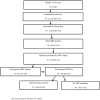Rates and Predictors of Non-Adherence to Antiretroviral Therapy among HIV-Positive Individuals in Kenya: Results from the Second Kenya AIDS Indicator Survey, 2012
- PMID: 27907114
- PMCID: PMC5131960
- DOI: 10.1371/journal.pone.0167465
Rates and Predictors of Non-Adherence to Antiretroviral Therapy among HIV-Positive Individuals in Kenya: Results from the Second Kenya AIDS Indicator Survey, 2012
Abstract
Introduction: Understanding the levels and associated factors of non-adherence to antiretroviral therapy (ART) is crucial in designing interventions to improve adherence and health outcomes of ART. We assessed non-adherence to ART among HIV-infected persons reporting ART use in a nationally representative survey in Kenya.
Methods: The Kenya AIDS Indicator Survey 2012 was a population-based, household survey of persons aged 18 months-64 years conducted in 2012-2013. Self-reported information was collected on demographics, sexual behaviour, HIV status, and ART use. Blood was collected for HIV testing, and if HIV infected, CD4 and viral load testing. HIV-positive specimens were tested for the presence of antiretroviral (ARV) drugs using a qualitative ARV assay using liquid chromatography-tandem mass spectrometry. HIV-positive persons who reported receiving ART but did not have the ARV biomarker present were defined as being non-adherent to their ARV medication. We restricted our analysis to HIV-infected persons aged 15-64 years who reported receiving ART and had laboratory-confirmed results from ARV testing. Multivariate logistic regression was used to identify variables associated with non-adherence.
Results: A total of 648 (5.6%; CI 4.9-6.3) tested HIV-positive of whom 559 (86.3%) had sufficient volume of blood to be tested for ARV drugs. Of those, 271 (47.7%; CI 41.8-53.6) self-reported HIV-positive status during the interview and 186 (69.1%; CI 62.2-76.0) of those reported taking ART. The ARV biomarker was absent in 18 of 186 individuals (9.4%; CI 4.9-13.8) who thus were defined as being non-adherent to ART. Non-adherence was associated with being aged 15-29 years (AOR 8.39; CI 2.26-31.22, p = 0.002) compared to aged 30-64 years, rural residence (AOR 5.87; CI 1.39-25.61, p = 0.016) compared with urban residence and taking recreational drugs in the past 30 days (AOR 5.89; CI 1.30-26.70, p = 0.022).
Conclusion: Overall, less than 10% of Kenyans aged 15-64 years on ART were not adhering to their HIV medication, highlighting the success of the Kenyan national ART program. Our findings, however, point to the need for targeted interventions particularly for young persons, those in rural areas to improve adherence outcomes, as well as delivery of treatment programs that include psychosocial support as a preventative measure to minimize substance abuse and the risk of treatment failure.
Conflict of interest statement
The authors have declared that no competing interests exist.
Figures

Similar articles
-
A comparison of self-report and antiretroviral detection to inform estimates of antiretroviral therapy coverage, viral load suppression and HIV incidence in Kwazulu-Natal, South Africa.BMC Infect Dis. 2017 Sep 29;17(1):653. doi: 10.1186/s12879-017-2740-y. BMC Infect Dis. 2017. PMID: 28969607 Free PMC article.
-
Detectable HIV Viral Load in Kenya: Data from a Population-Based Survey.PLoS One. 2016 May 18;11(5):e0154318. doi: 10.1371/journal.pone.0154318. eCollection 2016. PLoS One. 2016. PMID: 27192052 Free PMC article.
-
Use of viral load to improve survey estimates of known HIV-positive status and antiretroviral treatment coverage.AIDS. 2020 Mar 15;34(4):631-636. doi: 10.1097/QAD.0000000000002453. AIDS. 2020. PMID: 31794520 Free PMC article.
-
Interventions to improve medication adherence in adolescents with HIV: a systematic review and meta-analysis.J Investig Med. 2020 Oct;68(7):1217-1222. doi: 10.1136/jim-2020-001295. Epub 2020 Jul 22. J Investig Med. 2020. PMID: 32699066
-
Association between adherence to Antiretroviral Therapy and place of residence among adult HIV infected patients in Ethiopia: A systematic review and meta-analysis.PLoS One. 2021 Sep 2;16(9):e0256948. doi: 10.1371/journal.pone.0256948. eCollection 2021. PLoS One. 2021. PMID: 34473774 Free PMC article.
Cited by
-
Marker events associated with adherence to HIV/AIDS treatment in a cohort study.Rev Saude Publica. 2023 Apr 14;57:20. doi: 10.11606/s1518-8787.2023057004219. eCollection 2023. Rev Saude Publica. 2023. PMID: 37075403 Free PMC article.
-
The magnitude of adherence to option B plus program and associated factors among women in eastern African countries: a systematic review and meta-analysis.BMC Public Health. 2020 Nov 27;20(1):1812. doi: 10.1186/s12889-020-09903-y. BMC Public Health. 2020. PMID: 33246437 Free PMC article.
-
Factors Influencing Adherence to Antiretroviral Therapy (ART) among Adolescents Living with Human Immunodeficiency virus (HIV) in Rwanda.Rwanda J Med Health Sci. 2022 Dec 20;5(3):251-263. doi: 10.4314/rjmhs.v5i3.1. eCollection 2022 Dec. Rwanda J Med Health Sci. 2022. PMID: 40642347 Free PMC article.
-
Individual factors associated with time to non-adherence to ART pick-up within HIV care and treatment services in three health facilities of Zambézia Province, Mozambique.PLoS One. 2019 Mar 25;14(3):e0213804. doi: 10.1371/journal.pone.0213804. eCollection 2019. PLoS One. 2019. PMID: 30908522 Free PMC article.
-
Characterization of HIV-1 Integrase Gene and Resistance Associated Mutations Prior to Roll out of Integrase Inhibitors by Kenyan National HIV-Treatment Program in Kenya.Ethiop J Health Sci. 2020 Jan;30(1):37-44. doi: 10.4314/ejhs.v30i1.6. Ethiop J Health Sci. 2020. PMID: 32116431 Free PMC article.
References
-
- Joint United Nations Programme on HIV/AIDS (UNAIDS). On the Fast-Track to end AIDS by 2030: Focus on location and population. Geneva, Switzerland: UNAIDS; 2015.
-
- Ministry of Health (MOH). Kenya HIV estimates report, 2014. Nairobi, Kenya: MOH; 2014.
-
- National AIDS and STI Control Programme (NASCOP). National ARV stock status report. December 2012. Nairobi, Kenya: NASCOP; 2012. https://www.nascop.or.ke/index.php/commodity-logistics/
-
- Paterson DL, Swindells S, Mohr J, Brester M, Vergis EN, Squier C et al. Adherence to protease inhibitor therapy and outcomes in patients with HIV infection. Ann Intern Med. 2000; 133: 21–30. - PubMed
-
- Wood E, Hogg R, Yip B, Harrigan P, O'Shaughnessy M, Montaner J. The Impact of Adherence on CD4 Cell Count Responses Among HIV-Infected Patients. JAIDS Journal of Acquired Immune Deficiency Syndromes. 2004;35(3):261–268. - PubMed
MeSH terms
Grants and funding
LinkOut - more resources
Full Text Sources
Other Literature Sources
Medical
Research Materials
Miscellaneous

